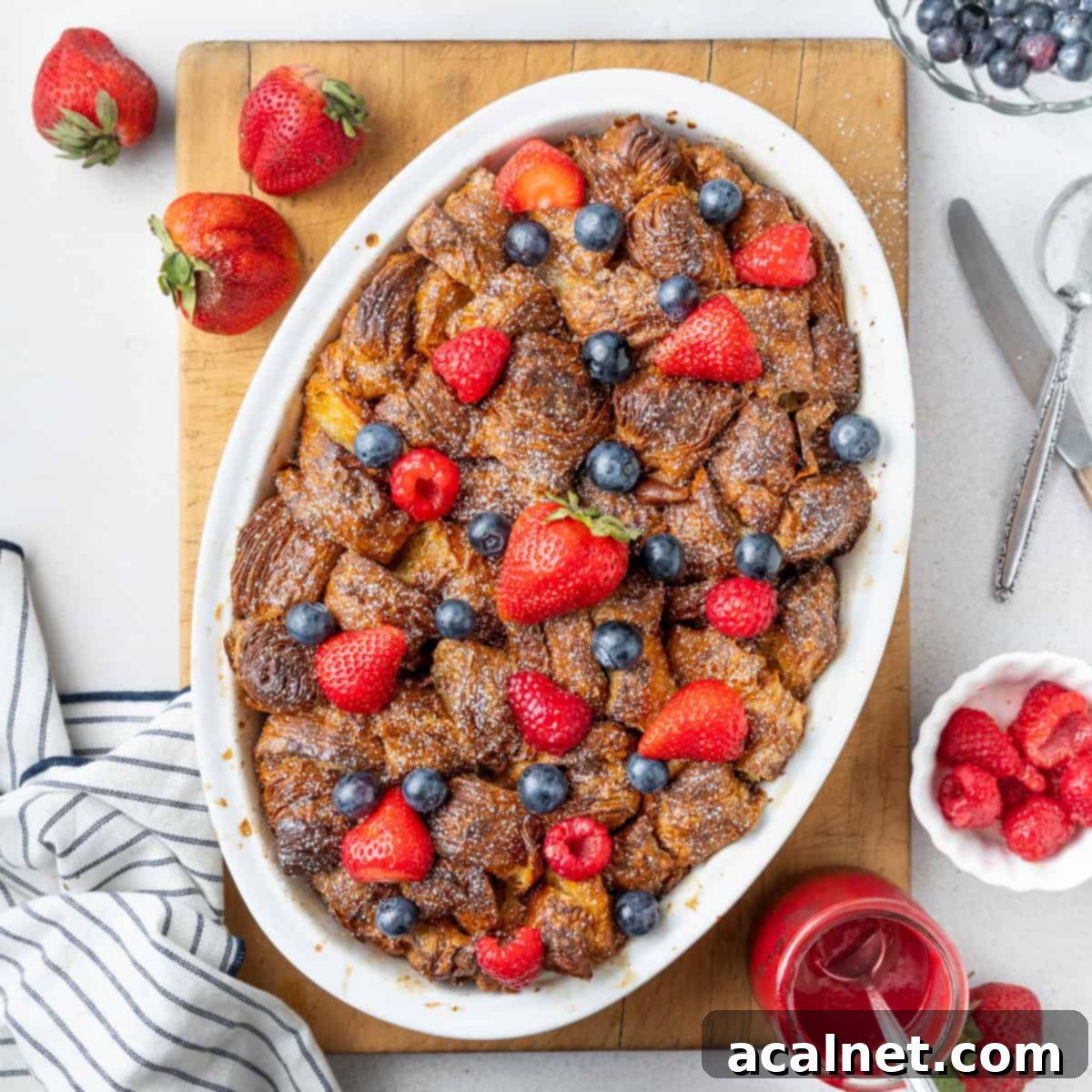The Ultimate Croissant French Toast Bake: Decadent & Easy Brunch Casserole
Prepare to be utterly captivated by this Croissant French Toast Bake – a dish so effortlessly elegant and incredibly delicious, it’s bound to become your new favorite for any occasion. Imagine the heavenly combination of soft, custardy croissants infused with a rich, spiced egg mixture, baked to perfection with delightfully crispy, flaky edges. This isn’t just breakfast; it’s an experience! Perfect for a festive holiday brunch, a leisurely weekend morning, or whenever you crave something truly special, this French toast casserole promises to be a memorable, crowd-pleasing centerpiece.
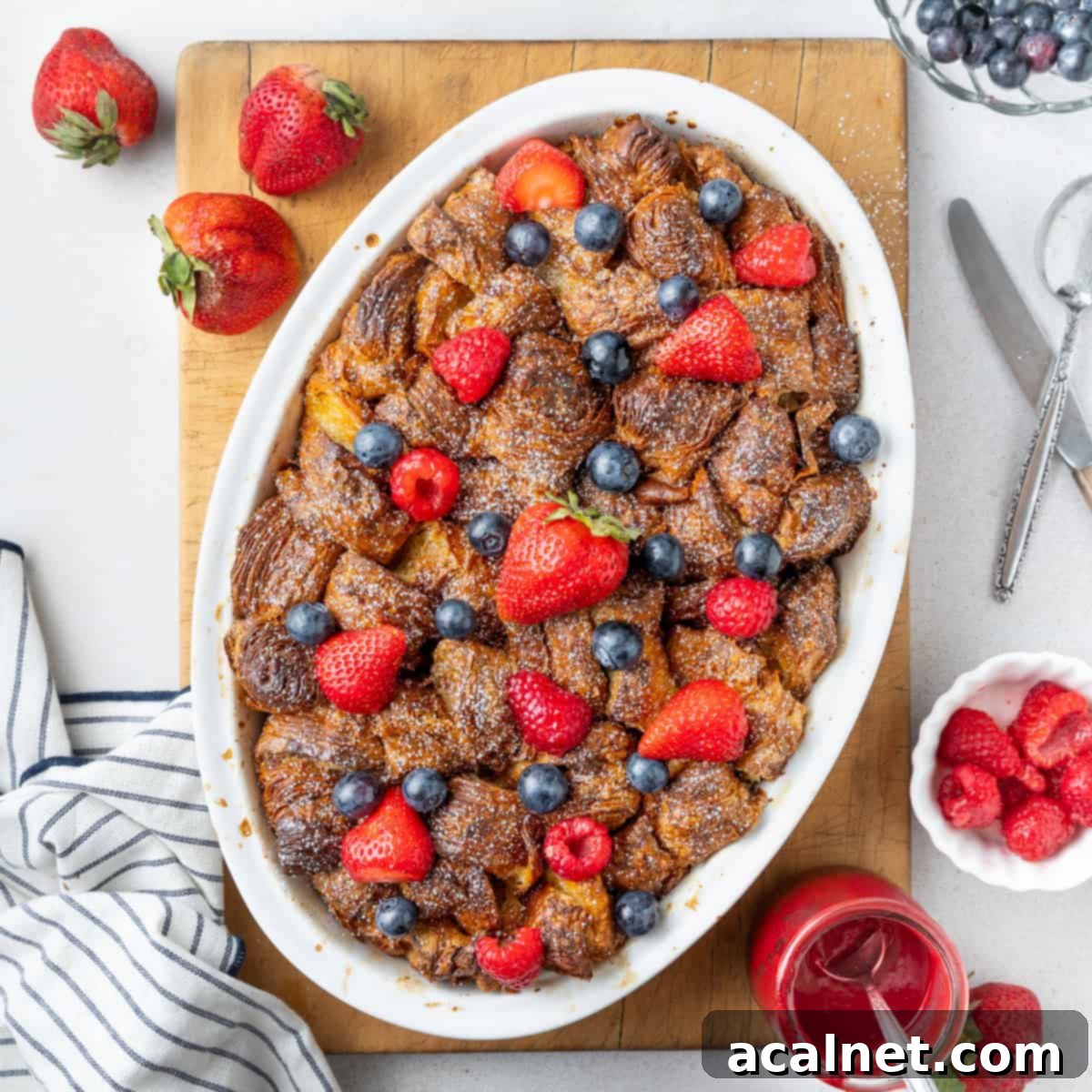
When it comes to indulgent and impressive breakfast dishes, this one truly takes the crown. What if I told you that achieving this level of culinary excellence requires only a handful of simple ingredients and minimal hands-on prep time? That’s right! Say goodbye to standing over a hot stove, frying individual French toast slices. This baked method allows you to assemble, bake, and then enjoy a magnificent spread with ease, making it the ultimate make-ahead brunch solution.
The magic happens in the oven: the rich, buttery essence of crispy croissants merges beautifully with the soft, fluffy texture of classic French toast. The result is a baked croissant French toast that delivers an unforgettable symphony of flavors and textures. It’s guaranteed to impress your family and guests, whether you’re serving it on Christmas morning, for a special Sunday brunch, or a relaxed weekend gathering. It’s comforting, satisfying, and looks absolutely stunning on the table.
Why You’ll Adore This Croissant French Toast Bake Casserole
This dish isn’t just delicious; it’s incredibly convenient and versatile. Here are just a few reasons why this easy croissant French toast bake recipe will become a cherished staple in your breakfast repertoire:
- Effortlessly Elegant: It looks and tastes gourmet, yet the preparation is surprisingly simple, making you look like a seasoned chef!
- Minimal Prep, Maximum Flavor: With just a few basic ingredients and a quick assembly, you get a deeply flavored, rich, and satisfying dish.
- Perfect for Crowds: This casserole style allows you to feed many people at once without the hassle of cooking individual servings. Ideal for family breakfasts, holiday brunches, or entertaining.
- Make-Ahead Friendly: Prepare it the night before and simply pop it in the oven in the morning. This is a game-changer for stress-free entertaining or busy mornings.
- Irresistible Texture Contrast: The combination of soft, custardy interiors with golden, flaky, slightly crispy croissant tops is truly divine. Each bite offers a satisfying crunch followed by melt-in-your-mouth tenderness.
- Highly Customizable: Easily adapt the flavors with various spices, fruits, nuts, or chocolate chips to suit any preference, ensuring everyone finds something to love.
Looking for more delectable French toast casserole ideas? Don’t miss my delightful Brioche French Toast Casserole for another equally impressive and simple-to-make option!
Essential Ingredients for Your Perfect Croissant French Toast Bake
Crafting this incredible breakfast bake begins with selecting the right components. Here’s a detailed look at what you’ll need and why each ingredient plays a crucial role in achieving the perfect flavor and texture for your French toast casserole:
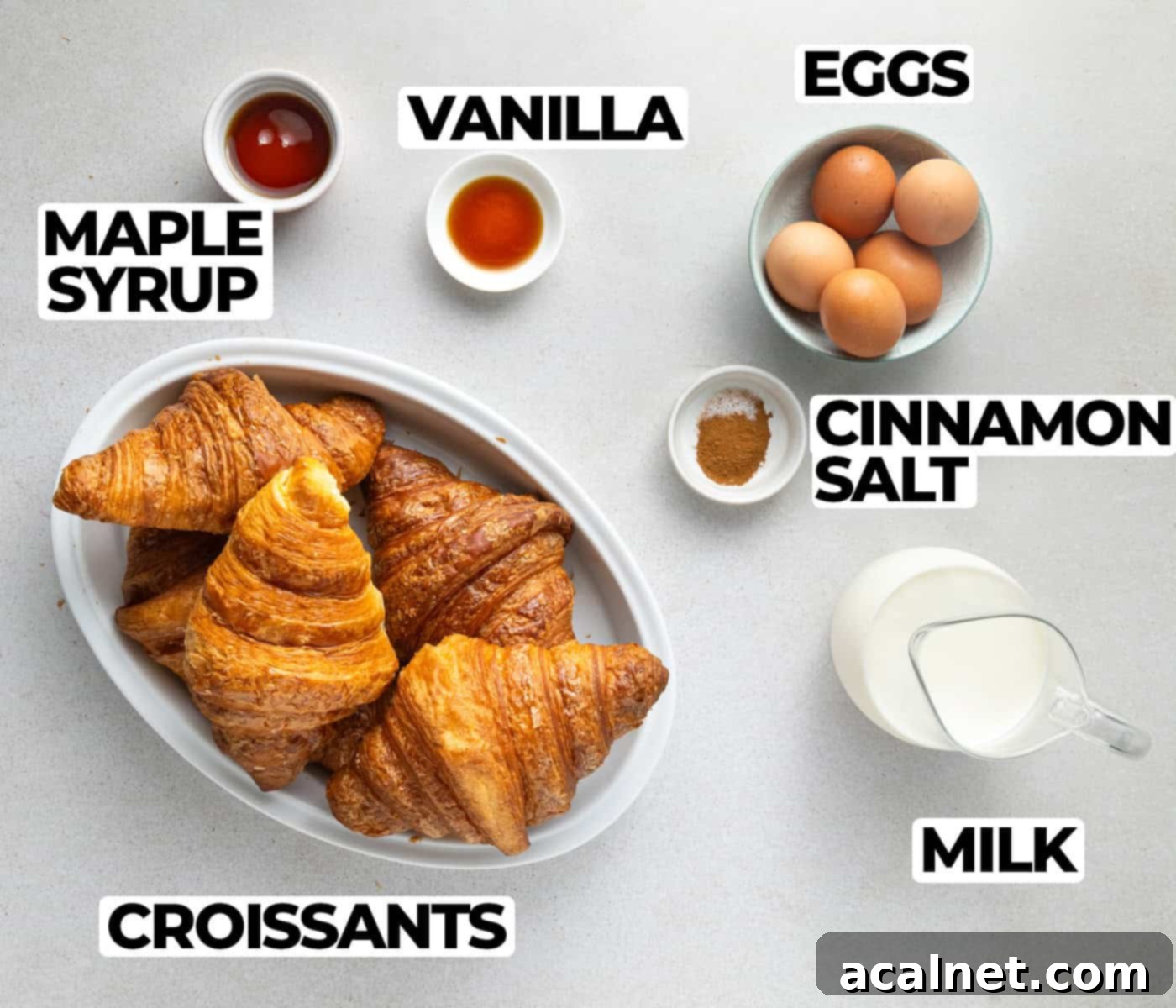
Scroll down to the full recipe card below for all exact quantities and detailed instructions.
- Croissants: The undeniable star of our French toast bake! For the absolute best flavor and texture, it’s paramount to choose good quality, pure butter croissants. These deliver the authentic rich, buttery taste and those coveted flaky layers that transform ordinary French toast into something extraordinary. **Day-old croissants are highly recommended here.** Why day-old? They are slightly drier and firmer, which allows them to absorb the egg custard more effectively without becoming mushy or soggy during baking. The amount you’ll need can vary based on their size; typically, 6 large to extra-large croissants are sufficient, but for smaller ones, you might need up to 8. Resist the urge to use cheap, non-butter croissants, as they simply won’t yield that desirable flaky, rich texture.
- Milk: Full Cream / Whole Milk is essential for creating a truly rich and creamy custard base. The higher fat content of whole milk contributes significantly to the decadent mouthfeel and helps prevent the bake from drying out, ensuring a moist and tender interior. I strongly advise against using low-fat or fat-free milk, as it will compromise the richness and overall luxurious texture of this elegant dish.
- Eggs: Large eggs serve as both the binding agent and the primary component of our custardy French toast mixture. There’s no effective substitute for eggs in this recipe, as they provide critical structure, add a lovely richness, and create that classic, velvety French toast texture. They work to emulsify with the milk and sweetener, forming a smooth, luxurious base that beautifully coats and penetrates the croissant pieces.
- Maple Syrup: My personal preference for its deep, complex, and natural sweetness that beautifully complements the buttery layers of the croissants. It adds an authentic, comforting flavor. However, you can certainly experiment with other sweeteners if you prefer. Brown sugar or honey are excellent alternatives, each adding a slightly different nuance to the final flavor profile. Granulated sugar can also work, but maple syrup or honey provide a more interesting depth and moistness.
- Ground Cinnamon: While technically listed as optional, I consider it a non-negotiable for its incredible flavor contribution! Cinnamon is a classic French toast spice for a reason; it brings out a wonderful warmth, aromatic depth, and a comforting scent that elevates the entire dish. If you’re feeling adventurous, a pinch of freshly grated nutmeg is equally delicious and adds a cozy, comforting aroma. You could even try a touch of allspice or a pumpkin spice blend for a more complex profile.
- Vanilla Extract: Another “optional but highly recommended” ingredient that truly enhances the overall experience. Vanilla rounds out the sweetness and adds a subtle, fragrant warmth that makes the custard irresistible. Simple vanilla extract or vanilla essence works perfectly fine here – there’s no need to splurge on expensive vanilla beans unless you want an extra touch of gourmet luxury.
- Fine Table Salt: Often overlooked in sweet recipes, just a pinch of fine table salt is crucial here. It effectively balances the flavors, cuts through the richness, and enhances the natural sweetness of the dish. It prevents the French toast from tasting flat and brings all the other ingredients into perfect harmony.
Creative Ingredient & Topping Variations to Explore
This Croissant French Toast Bake is a fantastic canvas for your culinary creativity! While I often serve it with a vibrant mix of fresh strawberries, raspberries, and blueberries, the possibilities for customization are truly endless. Feel free to experiment and make this dish uniquely yours:
- Adding Berries: Beyond just topping, you can also fold fresh or frozen berries directly into the croissant mix before baking for bursts of juicy fruit throughout the casserole. If using frozen berries, toss them lightly with a teaspoon of flour before adding to help prevent them from sinking to the bottom and releasing too much moisture into the custard.
- Chocolate Chips: For a more decadent and kid-friendly treat, generously scatter chocolate chips (dark, milk, or white chocolate work beautifully!) over the croissant pieces before pouring over the remaining custard and baking. They’ll melt into gooey, irresistible pockets of chocolatey goodness.
- Nuts for Crunch: Add a delightful textural contrast and nutty flavor with a sprinkle of slivered almonds, chopped walnuts, or pecans. Lightly toasting the nuts in a dry pan for a few minutes before adding them will enhance their flavor and aroma significantly.
- Citrus Zest: A touch of finely grated orange or lemon zest mixed into the custard can add a bright, fresh, and aromatic counterpoint to the richness of the croissants and custard.
- Dried Fruit Infusion: Incorporate chewy, sweet elements by mixing in raisins, dried cranberries, chopped apricots, or even finely diced candied ginger. These add depth and a different kind of sweetness.
- Cream Cheese Swirl: For an extra rich and tangy element, prepare a simple cream cheese mixture. Combine 4 oz (113g) softened cream cheese with 2-3 tablespoons of sugar and an egg yolk, then dollop it over the croissants before baking. Swirl it gently with a knife for a beautiful marbling effect.
- Spiced Syrups: Instead of plain maple syrup, try infusing your maple syrup with a cinnamon stick, star anise, or orange peel while warming it for an extra layer of flavor.
Step-by-Step Guide: How to Make This Irresistible Croissant French Toast Casserole
Creating this magnificent baked French toast casserole is surprisingly straightforward, making it perfect for both novice and experienced bakers. Follow these detailed steps for a perfect, golden-brown, and custardy French toast bake every time:
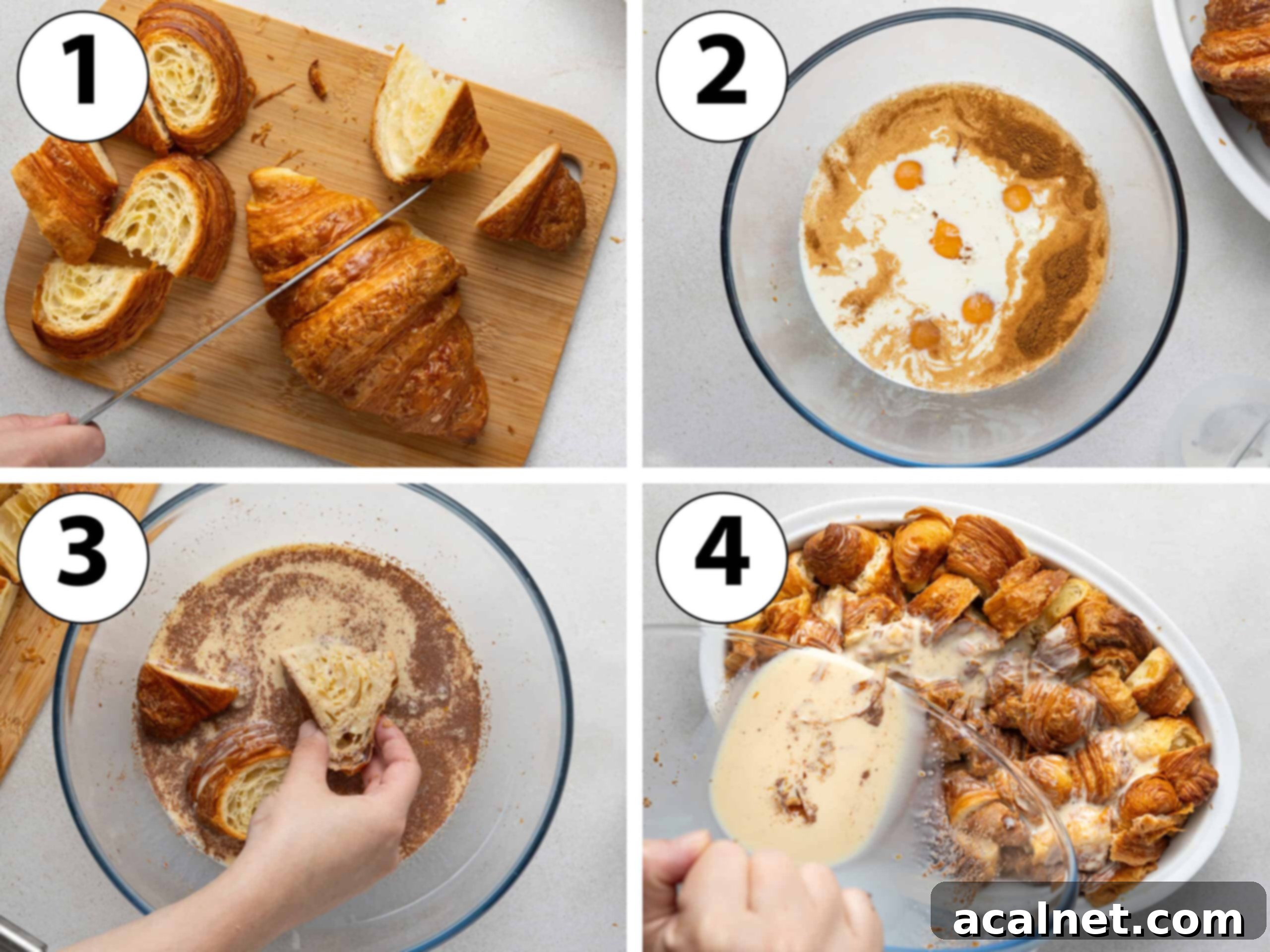
- Step 1: Preheat Your Oven and Prepare the Dish. Begin by preheating your oven to 180 degrees Celsius (350 degrees Fahrenheit). It’s crucial for the oven to be at the correct temperature for even baking from the moment your casserole goes in. Lightly grease your chosen baking dish – a large ceramic or glass casserole dish works beautifully. This prevents sticking and ensures easy serving.
For reference, I used a 25 x 35 cm (10 x 14 inch) oval dish, but any rectangular dish approximately 20 x 30 cm (8 x 12 inch) will yield fantastic results. The key is to have a dish that allows the croissant pieces to be packed relatively snugly, creating a cohesive casserole rather than scattered pieces.
- Step 2: Slice the Croissants into Chunks. (Photo 1) Carefully cut your day-old croissants into large, rustic chunks. The size isn’t overly critical, but aim for substantial pieces that will hold their shape well during the soaking and baking process, offering a satisfying bite. Uniformity helps with even cooking, but don’t stress over perfection. Set these aside while you prepare the custard.
- Step 3: Whisk Together the Rich Custard. (Photo 2) In a large mixing bowl, combine the large eggs, full cream milk, maple syrup, ground cinnamon, vanilla extract, and a pinch of fine table salt. Whisk vigorously using a balloon whisk until all the ingredients are thoroughly combined and you achieve a smooth, uniform mixture. Ensure there are no streaks of egg yolk or white. Don’t worry if the cinnamon seems to float a bit on the surface; that’s perfectly normal and will blend in as it bakes and the custard thickens.
- Step 4: Briefly Soak the Croissant Pieces. (Photo 3) Take each croissant piece and quickly dip it into the prepared egg mixture. Allow it to soak for just a few seconds on each side – the goal is for the croissant to absorb some of the custard’s flavor and moisture, but not to become completely saturated and mushy. This quick dip helps retain some of that delightful flakiness while ensuring the interior becomes wonderfully custardy.
- Step 5: Arrange and Pack in the Dish. As soon as each croissant piece is soaked, transfer it directly into your prepared baking dish. Arrange them, layering and packing them very tightly. Don’t be afraid to push the pieces around to ensure all your croissants fit snugly within the dish. A tight pack is crucial for the casserole to hold its shape, for the custard to set properly around all the pieces, and to prevent excessive drying during baking.
Note on Dish Size and Packing: Depending on the exact dimensions of your baking dish and the number/size of croissants you use, the dish might appear more or less packed, and the height of the casserole will vary. If your dish is larger and results in a thinner layer, you may need to slightly adjust the baking time (it will likely bake more quickly). Conversely, a deeper, smaller dish might require a longer bake. Aim for a full dish for the best results.
- Step 6: Pour the Remaining Custard Over. (Photo 4) Once all the soaked croissants are arranged in the dish, pour any remaining egg custard mixture evenly over the top. Gently tilt the dish if needed to ensure the liquid seeps into all the gaps and covers the croissant pieces thoroughly. This guarantees every nook and cranny is filled with the rich liquid, contributing to a consistently moist and flavorful bake.
- Step 7: Bake to Golden Perfection. Place the baking dish into your preheated oven and bake for approximately 45 to 60 minutes. The baking time can vary slightly depending on your oven’s calibration and the thickness of your casserole. Look for a beautifully golden-brown and flaky top, and ensure the custard has fully set – there should be no visible liquid or jiggliness when you gently shake the dish. If the top starts browning too quickly before the inside is cooked, you can loosely tent it with aluminum foil to prevent burning.
- Step 8: Cool and Serve. Once baked, carefully remove the casserole from the oven and allow it to cool down for at least 15 minutes before serving. This crucial cooling period allows the custard to further set and firm up, making it much easier to portion and serve cleanly. If you’re preparing it in advance as a make-ahead brunch, let it cool completely on a wire rack, then cover it tightly with plastic wrap and store it in the fridge until ready to reheat.
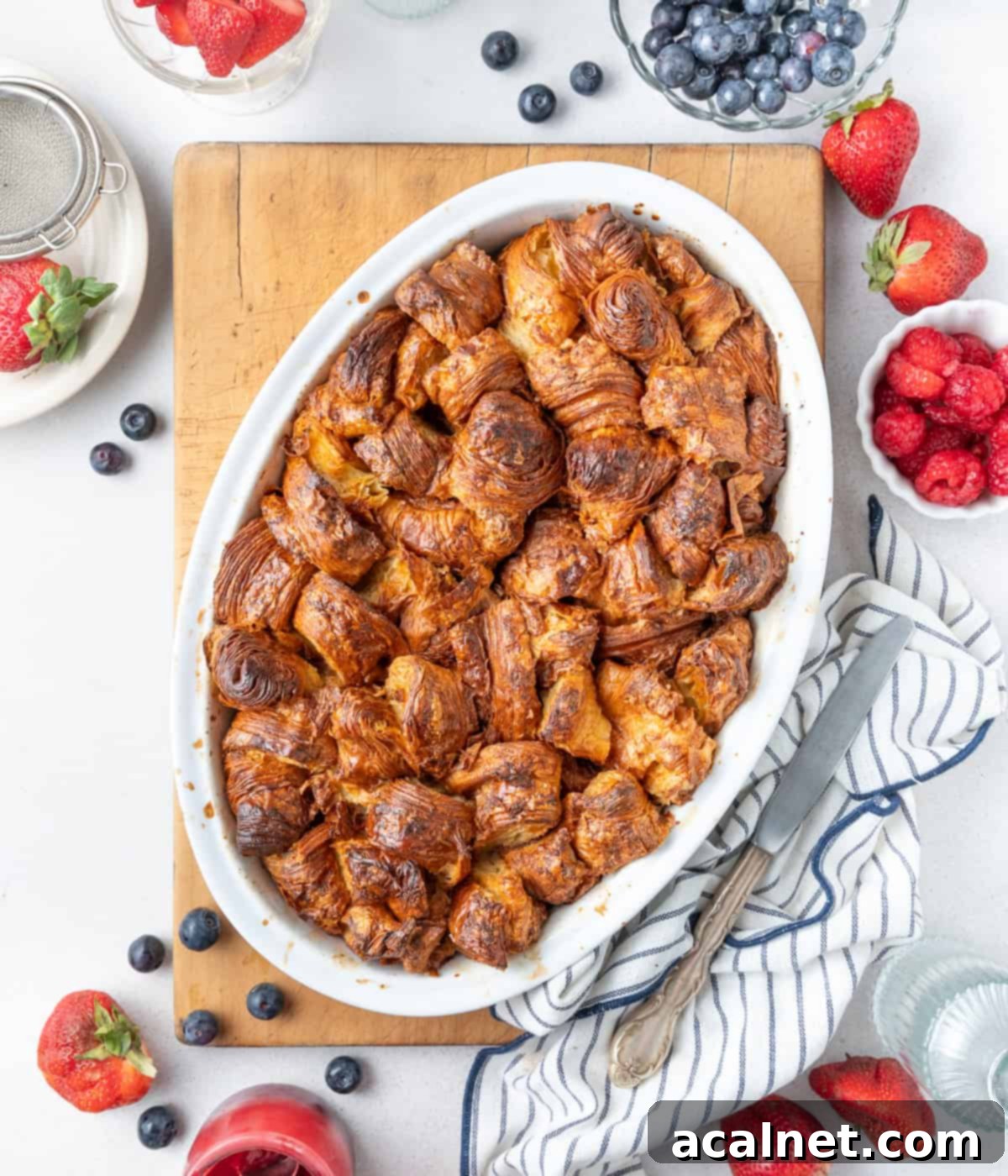
Frequently Asked Questions About Croissant French Toast Bake
For an unparalleled flavor and texture in your Croissant French Toast Bake, it’s crucial to use good quality, pure butter croissants. Genuine French-style croissants, though sometimes a bit more expensive, are absolutely worth the investment. Their rich butter content and flaky layers are what make this dish truly special. Avoid cheaper supermarket croissants made with oil or margarine, as they lack the buttery taste and crispy layers, often resulting in a soggy French toast bake. Additionally, **day-old croissants** are highly recommended because their slightly drier texture allows them to better absorb the egg mixture without becoming mushy or waterlogged during baking, ensuring a perfectly custardy interior with crisp edges. If you only have fresh croissants, you can lightly toast them in a low oven (120°C/250°F) for 10-15 minutes to dry them out slightly before use.
Absolutely, and that’s one of the most convenient aspects of this recipe, making it ideal for stress-free entertaining! To prepare it in advance, you have a couple of excellent options:
- **Assemble and Refrigerate Overnight:** You can assemble the entire casserole the night before. Once the soaked croissants are arranged in the baking dish and topped with the remaining custard, cover the dish tightly with plastic wrap or aluminum foil and refrigerate it overnight (up to 12-18 hours). In the morning, simply remove it from the fridge about 30 minutes before baking to take off the chill while the oven preheats, then bake as directed. You might need to add an extra 5-10 minutes to the baking time since it’s starting from cold.
- **Partially Bake and Reheat:** Another method is to slightly underbake the casserole (about 30-35 minutes) until just set but not fully golden. Let it cool completely, then cover and refrigerate. When ready to serve, pop it back into the preheated oven for 10-15 minutes, or until fully heated through and golden brown. This is a great technique for maintaining a crisper top.
Yes, you can certainly soak the croissants overnight! This method will result in an even softer, more thoroughly saturated custardy texture throughout the entire casserole, similar to a bread pudding. If you prefer a very tender, melt-in-your-mouth French toast experience where the croissant almost completely melts into the custard, this overnight soak works wonderfully. However, if you enjoy a delightful mix of crispy edges and soft interiors, a quicker soak (as outlined in the main instructions) might be better. As explained in the make-ahead tips above, the dish reheats beautifully the next day, offering another great way to prepare it in advance and simply finish baking or reheat in the morning.
While the recipe calls for full-cream milk to achieve its signature richness and decadent flavor, you can certainly try a dairy-free version. Replace the whole milk with a rich, unsweetened plant-based milk like full-fat oat milk, almond milk, or cashew milk. Ensure the milk is unsweetened to maintain control over the sugar content in the recipe. The flavor profile will be slightly different due to the distinct taste of plant-based milk, but it will still be a delicious and satisfying alternative for those avoiding dairy.
The tell-tale signs of a perfectly cooked Croissant French Toast Bake include a beautifully golden-brown and slightly flaky top. When you gently shake the baking dish, the center should appear set and firm, with no visible liquid or jiggling custard. You can also carefully insert a thin knife or a wooden skewer into the center; if it comes out clean with no wet batter, the custard is fully set. The delightful aroma filling your kitchen will also be a strong indicator of its readiness!
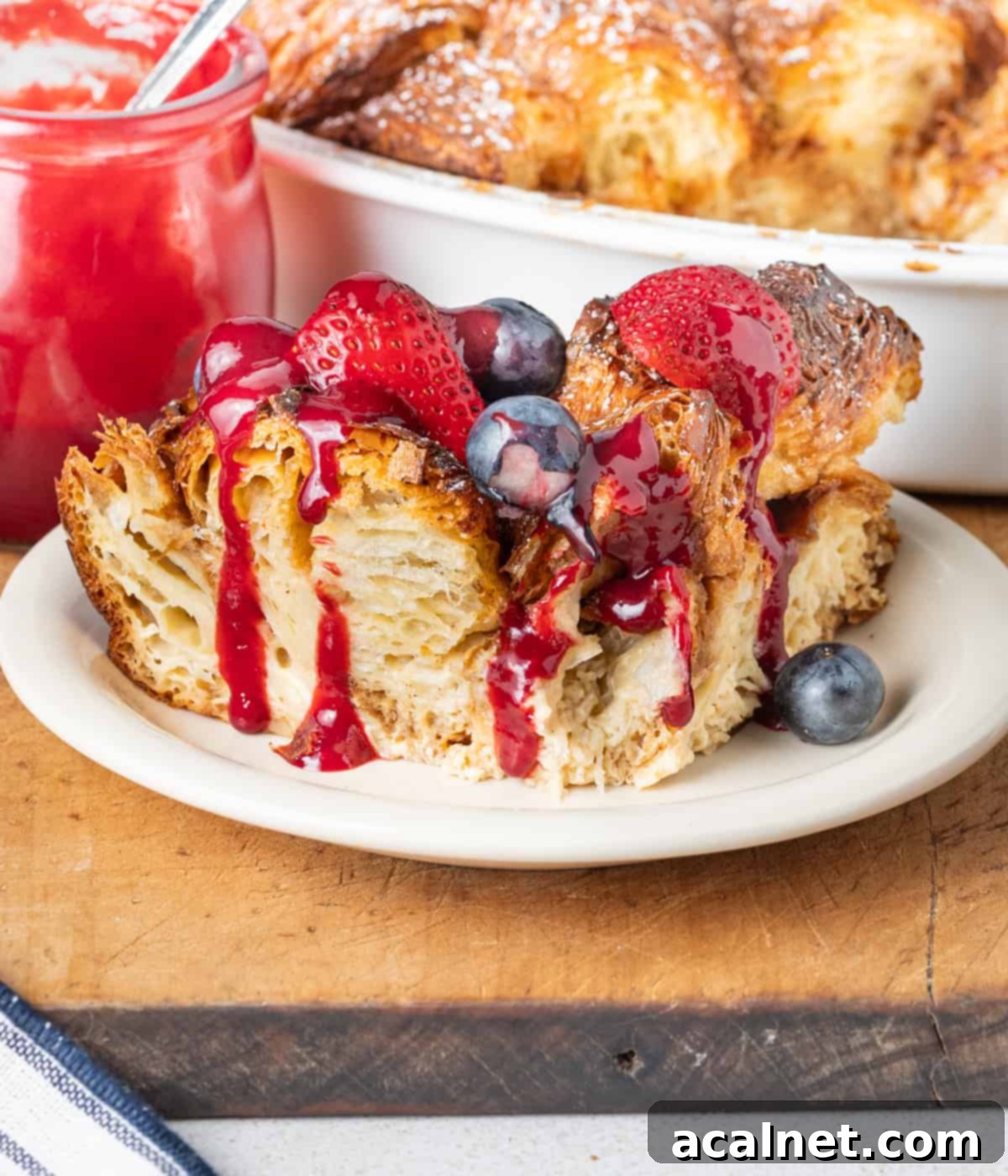
Delicious Serving Suggestions for Your Croissant French Toast Bake
The beauty of this Croissant French Toast Bake lies not only in its inherent deliciousness but also in its incredible versatility when it comes to serving. While a simple dusting of powdered sugar and fresh berries is always a winning combination, there are countless ways to elevate your brunch experience and truly make this dish shine. Here are some of my favorite ideas to inspire your culinary creativity:
- Classic Fresh Berries & Powdered Sugar: A timeless and elegant choice for a reason! The vibrant, slightly tart freshness of ripe strawberries, raspberries, and blueberries perfectly complements the rich sweetness and buttery notes of the French toast. A light dusting of powdered sugar adds a touch of visual appeal and extra sweetness.
- Homemade Fruit Coulis: A fruit coulis adds a beautiful pop of intense color and a concentrated fruity flavor. I highly recommend a homemade Raspberry Coulis for its sweet-tart profile. You could also try a tropical Passion Fruit Coulis for exotic zest, a sunny Mango Coulis for lush sweetness, or a classic Strawberry Coulis for a taste of summer.
- Luxurious Whipped Creams: Elevate the decadence with a generous dollop of light and airy Chantilly Cream (sweetened whipped cream) or a richer, more stable Mascarpone Whipped Cream. These add a luxurious, creamy texture that melts beautifully into the warm French toast, creating a truly indulgent bite.
- Warm Fruit Compotes: For a more rustic, fruit-forward, and comforting topping, spoon over a warm fruit compote. My favorites include a rich Cherry Compote, a vibrant Mixed Berry Compote brimming with seasonal fruits, or a sweet and mellow Peach Compote. These offer a comforting, homestyle touch and extra moisture.
- Tangy Fruit Curds: Bright, tangy fruit curds provide a delightful burst of citrusy or intense fruity brightness that cuts through the richness of the French toast. Experiment with a zesty Lemon Curd, a unique and comforting Apple Curd, or an exotic Passion Fruit Curd for a truly gourmet twist.
- Go “All French” with Crème Anglaise: For an authentic and sophisticated French touch, serve your Croissant French Toast Bake with a silky smooth Crème Anglaise (a classic vanilla custard sauce). Its delicate vanilla flavor and creamy texture are a match made in heaven for any French toast creation.
- Maple Syrup or Honey: A generous drizzle of high-quality pure maple syrup or warm, runny honey is a simple yet incredibly effective way to add more natural sweetness and moisture. The flavors meld perfectly with the buttery croissants.
- Other Fresh Fruits: Don’t limit yourself to just berries! Sliced fresh bananas, caramelized bananas, juicy peaches, sweet nectarines, or even sautéed and spiced apple slices can be fantastic additions for varying flavors and textures.
- A Sprinkle of Crunch: Toasted nuts (such as pecans, walnuts, or slivered almonds) or a sprinkle of your favorite granola can add an extra layer of delightful crunch and texture, contrasting beautifully with the soft interior.
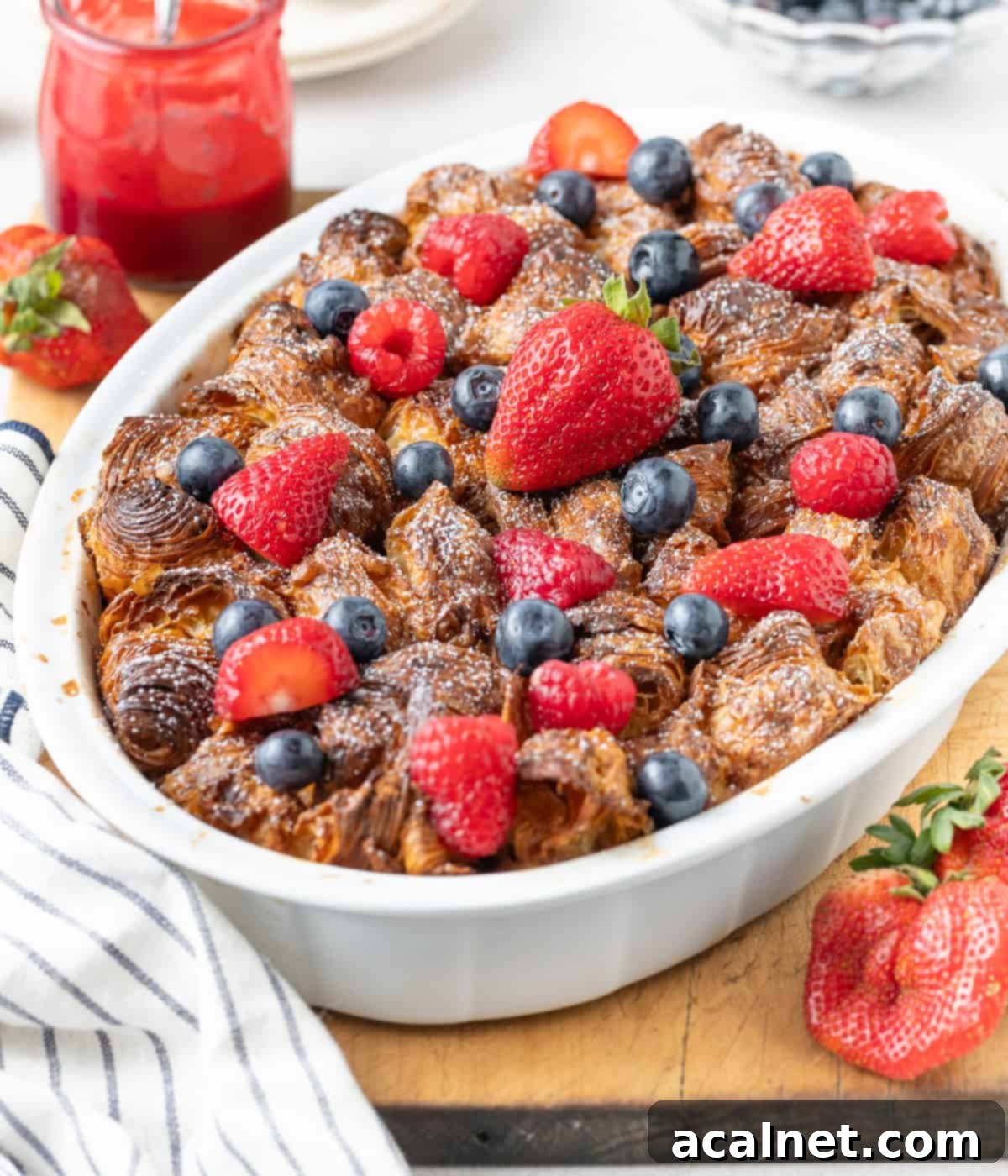
Pro Tips & Troubleshooting for a Perfect Croissant French Toast Bake
Achieving the ideal Croissant French Toast Bake is simple with a few insider tips and solutions to common issues. These insights will help you create a consistently delicious and perfectly textured breakfast casserole every time:
- Understanding and Preventing a Soggy Bake: This is arguably the most common concern when making any French toast casserole. A soggy casserole can happen for several key reasons:
- Insufficient Baking Time: The most frequent culprit. Ensure the casserole bakes long enough for the custard to fully set in the center. The middle should not be liquid or jiggly when gently nudged.
- Croissants Are Too Fresh: As emphasized, day-old croissants are best. Fresh croissants are too soft and will absorb too much liquid too quickly, becoming mushy rather than custardy. Their structure breaks down, leading to a heavy, damp result.
- Over-Soaking: Don’t let the croissant pieces sit in the custard for an extended period (unless you’re intentionally aiming for an overnight soak for a bread pudding-like consistency). A quick dip is enough for them to absorb flavor without becoming oversaturated.
- Incorrect Liquid Ratio: Always stick to the recipe’s specified liquid-to-croissant ratio. Too much liquid can overwhelm the croissants and lead to a watery, unset custard, especially if the dish isn’t packed tightly enough.
- How to Know When It’s Fully Baked: A perfectly baked Croissant French Toast Bake will have a beautifully golden-brown and visually flaky top, showcasing the croissant’s natural layers and butter content. The custard itself should be completely set; it will appear firm and cooked through, with no visible liquid around the croissant pieces when you gently shake the dish. You can also insert a knife into the center, and if it comes out clean, the custard is fully set.
- Achieving the Best Texture Balance: For that delightful contrast between a soft, custardy interior and a crisp, flaky top, make sure to arrange your croissant pieces with different sides facing up. Alternate between placing pieces with their flaky exterior facing upwards (which will crisp up wonderfully) and those with softer inside chunks (which will become beautifully tender). This thoughtful arrangement ensures a varied and satisfying texture in every bite.
- The Crucial Role of Day-Old Croissants: I cannot stress this tip enough! Stale, day-old croissants are inherently superior for this recipe. Their slightly dried-out texture is perfect for soaking up the rich egg mixture without disintegrating or turning soggy in the oven. This allows them to swell and become beautifully custardy inside while the exposed surfaces develop that irresistible golden crunch. If you only have fresh croissants, you can lightly toast them in the oven for about 10-15 minutes at 120°C (250°F) to dry them out slightly before using.
- Don’t Overcrowd the Custard Bowl: Use a bowl that is large enough to easily dip your croissant pieces without making a mess or rushing the process. This allows for controlled, quick soaking.
- Gentle but Firm Pressing: When arranging the soaked croissants in the baking dish, press them down gently but firmly to ensure they are packed tightly. This helps the casserole maintain its structure during baking and allows the custard to evenly distribute and set.
- Cover if Browning Too Quickly: If you notice the top of your casserole browning too quickly (turning dark brown) before the inside is fully cooked and the custard is set, loosely tent the dish with aluminum foil. This will prevent the top from burning or becoming overly dry while allowing the interior to finish baking undisturbed.
Storing & Reheating Your Croissant French Toast Bake
Proper storage and reheating techniques are key to ensuring you can enjoy this delicious bake for days to come, minimizing waste and maximizing convenience:
- Storing Leftovers: Once the croissant French toast bake has completely cooled to room temperature, cover the baking dish tightly with plastic wrap or aluminum foil, or transfer individual portions to an airtight container. Store it in the refrigerator for up to 3 days. This ensures it remains fresh and delicious for future enjoyment.
- Reheating Instructions:
- In the Oven (Recommended for Best Texture): For the best results, whether reheating the full casserole or larger portions, preheat your oven to 160°C (325°F). Place the casserole in the oven, covered loosely with aluminum foil to prevent the top from burning or drying out. Reheat for about 15-20 minutes, or until warmed through to the center. Individual slices can be reheated uncovered for a slightly crispier result.
- In the Microwave (Quick Option): Individual portions can be quickly reheated in the microwave. Place a slice on a microwave-safe plate and heat for 30-60 seconds, or until warm. Be aware that the microwave tends to make the texture softer and can reduce any crispiness that was present.
- Freezing: I do not recommend freezing this dish. Croissants tend to lose their delicate flaky texture and can become somewhat soggy or rubbery after thawing and reheating. Additionally, the custard base can develop an undesirable watery or grainy texture when frozen and then reheated. For optimal quality, it’s best enjoyed fresh or from the refrigerator within a few days.
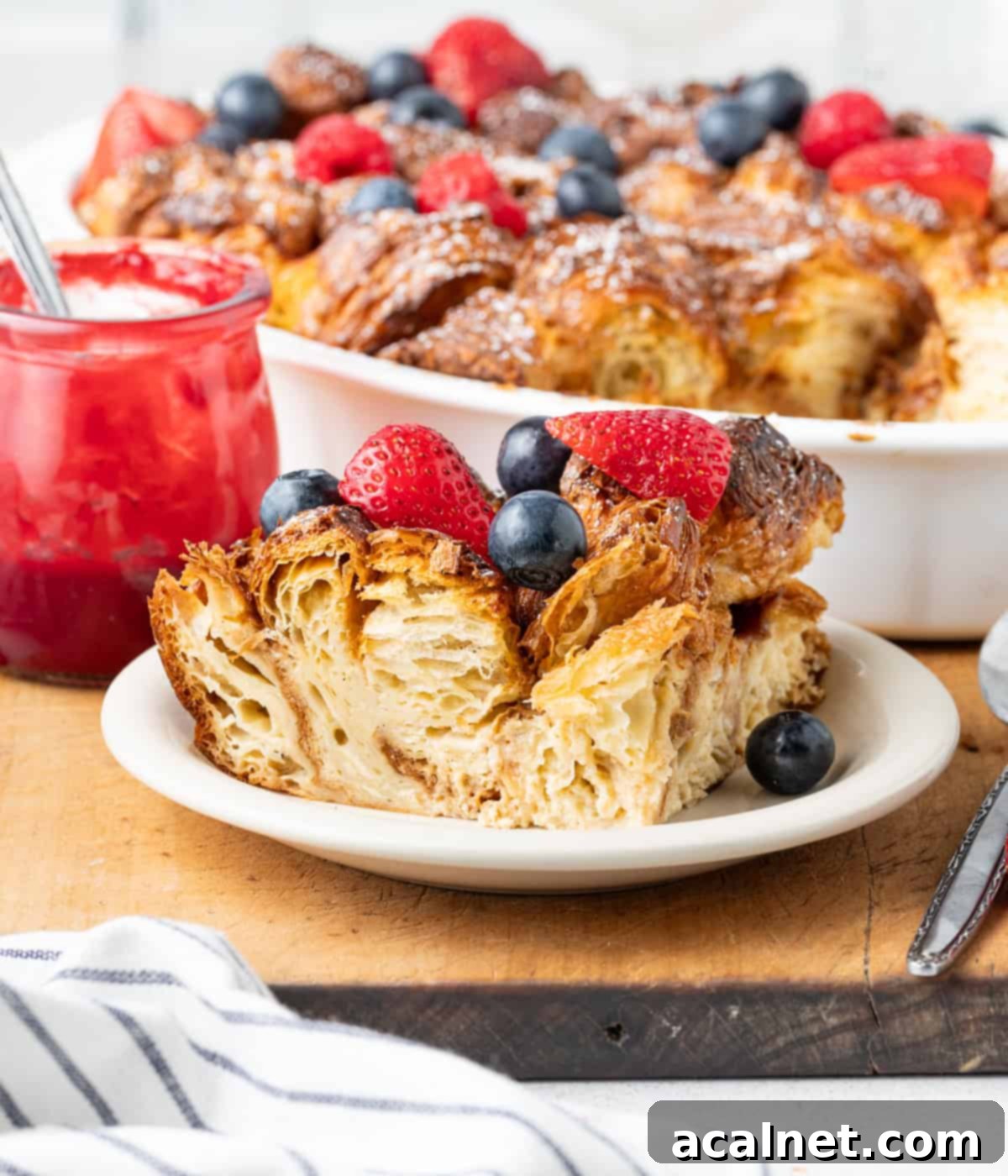
More Delightful Breakfast & Brunch Ideas
If you loved this decadent Croissant French Toast Bake, you’re in for a treat! Explore more delicious and inspiring recipes to elevate your mornings and special gatherings, perfect for any time you want to add a touch of joy to your table:
- Simple 3-Ingredient Banana Pancakes: A quick, healthy, and naturally sweet start to your day.
- Classic Brioche French Toast: For a rich and fluffy twist on traditional French toast.
- Irresistible Triple Chocolate Cinnamon Rolls: A chocolate lover’s dream, perfect for a special breakfast.
- Homemade Chocolate Chip Brioche Bread: A buttery, tender bread studded with chocolate chips, great for toast or sandwiches.
- Authentic French Crêpes: Thin, delicate pancakes perfect with sweet or savory fillings.
- Comforting Apple Cinnamon Baked Oatmeal: A cozy and wholesome make-ahead breakfast option.
I am so excited to share that my debut cookbook
“Bite-Sized French Pastries for the Beginner Baker”
is now available for purchase!
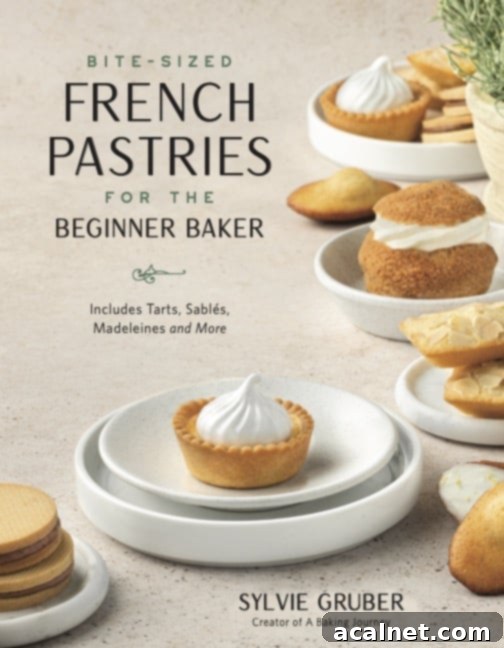
Full Recipe Card: Croissant French Toast Bake

Croissant French Toast Bake
Print Recipe
Equipment
- 20 x 30 cm baking dish or casserole
Ingredients
- 6 to 8 Croissants, (day-old, pure butter recommended – see note 1)
- 5 large Eggs
- 500 ml Full Cream Milk / Whole Milk
- 60 ml Maple Syrup
- 1 1/2 teaspoon Vanilla Extract
- 1 teaspoon Ground Cinnamon
- 1 pinch Fine Table Salt
Instructions
- Preheat your oven on 180 degrees Celsius / 350 degrees Fahrenheit and prepare a 20 x 30 cm / 8 x 12 inch glass or ceramic baking dish (see note 2). Lightly grease the dish to prevent sticking.
- Cut each croissant into large, roughly equal chunks. Set aside on a clean surface.
- In a large mixing bowl, whisk together the eggs, full cream milk, maple syrup, ground cinnamon, vanilla extract, and a pinch of fine table salt until you get a smooth, well-combined mixture. Don’t worry if the cinnamon tends to float to the surface, that’s normal and it will distribute during baking!
- Dip each croissant chunk into the egg mixture, allowing it to soak for only a few seconds on each side to absorb some liquid but retain its flaky texture. Immediately transfer the soaked croissant pieces into the prepared baking dish, packing them very tightly. Continue this process until all croissant chunks have been soaked and arranged snugly in the dish (see note 3).
- Pour any remaining egg custard mixture evenly over the croissants in the baking dish, ensuring all surfaces and gaps are covered.
- Bake for 45 to 60 minutes, or until the top of the croissants is golden brown and flaky, and the custard has fully set (the center should not be liquid or jiggly). If the top begins to brown too quickly, loosely tent the dish with aluminum foil.
- Allow the French toast bake to cool down for at least 15 minutes before serving. This cooling period is important for the custard to set properly and makes serving much easier. If making in advance, let it cool completely, then cover tightly with plastic wrap and store in the fridge.
- Optionally dust with powdered sugar, drizzle with extra maple syrup, and serve warm with your preferred toppings, such as fresh berries or whipped cream!
Would you like to save this recipe?
We’ll email this post to you, so you can come back to it later!
Notes
- The number of croissants needed can vary based on their size. For this particular recipe, I used relatively large croissants and needed about 6 1/2 croissants to fill my dish appropriately. If you are using smaller croissants (e.g., mini croissants or standard bakery size that aren’t “large”), you may need to increase the quantity up to 8 to fill the dish adequately and achieve a good height. Always prioritize good quality, pure butter croissants for the best flavor and texture.
- I successfully used a 25 x 35 cm (10 x 14 inch) oval baking dish for this recipe, which yielded a nicely thick casserole. However, any rectangular dish around 20 x 30 cm (8 x 12 inch) will also work beautifully. Keep in mind that if you use a larger dish, the casserole will be thinner, and the baking time might need to be slightly adjusted (potentially shorter) to prevent it from drying out. Conversely, a smaller, deeper dish might require a longer baking time to ensure the center is fully cooked.
- Ensuring the croissants are packed tightly in the dish is important for the casserole to hold its structure and for the custard to properly set around all pieces, creating a cohesive dish. The baking dish should look quite full with the croissant chunks. If you find your casserole is less tall (e.g., when using a wider, shallower dish), the baking time may need slight adjustment to ensure the custard sets through without over-browning the top. Monitor closely during the final 15-20 minutes of baking.
Nutrition (per serving)
Made this irresistible recipe?
We’d love to hear from you! Please let us know if you enjoyed it by leaving a comment below. And don’t forget to tag us on Instagram @a.baking.journey with a photo of your delightful creation!
